My cat loves Aldi’s cat treats, and few years ago, I offered my cat some of Aldi’s dry cat food, but she was less than thrilled with the dry food. In contrast, some readers have mentioned that their cats like Aldi’s canned cat food, so it seemed like a good time to do some additional research.
Aldi sells two different sizes of canned cat food: three flavors in 3-oz. cans for 49 cents each, and three flavors in 5.5-oz. cans for 39 cents each. I’m not sure why the smaller cans cost more, but it’s possible it has to do with economy of scale and that the can with the larger volume requires less raw material to manufacture. National brands such as Purina and Fancy Feast also sell larger cans at a lower cost. Overall, Aldi sells a total of six different flavors ranging from salmon to chicken to beef, and more. They are Regular Buys, which means Aldi sells them all year.
All of Aldi’s canned cat food is all a product of Canada, and the cans say they are formulated to meet the nutritional levels established by the AAFCO Cat Food Nutrient Profiles for Growth and Maintenance. Cat owners are encouraged to feed according to age, size, and activity of their cats. The canned food should be offered at room temperature, and unused portions should be refrigerated.
While canned cat food costs more than dry cat food, both types of cat food are nutritionally complete. The consensus from most vets is that whether you feed your cat dry food or canned food, it should be a high-quality food. The main difference between the two, according to petfinder.com, is the moisture content. This can be helpful for cats with kidney or lower urinary tract issues. The higher moisture content may also help your cat to feel more full while still consuming the same amount of calories as dry food. In contrast, if your cat has a lot of dental issues, dry food may be better at helping to keep his or her teeth cleaner.
Catster.com also mentions that cats on a dry food diet may be more vulnerable to obesity and diabetes because of higher carbohydrate levels, and because many cat owners who feed dry food leave it out continually, possibly not limiting how much a cat consumes.
Catster and vetinfo.com recommend that if you feed your cat a canned food, it should list an animal protein source as the first ingredient, and ideally it should not have meat by-products. Spoiler: all of Aldi’s canned cat foods contain meat by-products, and the Salmon Entree and Turkey & Giblets Entree both list meat by-products as the first ingredient. A quick search indicates that popular name-brand cat foods such as Purina Friskies, 9 Lives, and Fancy Feast also contain meat by-products.
Vetinfo.com also recommends that canned cat food have taurine, an essential amino acid, and all of Aldi’s canned cat foods do have it. Aldi’s canned cat food also seems to avoid some less desirable ingredients, including corn and other grains, soy, bone meal, and added sugar. The 78% moisture level in all of Aldi’s canned cat food also is the minimum ideal, according to vetinfo.com.
As for what my 14-year-old cat thought of Aldi’s canned food, she approved. She usually receives measured portions of dry food every morning and every evening, and we offered her one can every other morning in place of her usual dry food, eventually working through all six flavor options. She did not waste any time chowing down and sometimes tried to nose in while we were still opening the can. While I primarily feed my cat Purina dry food, she occasionally shows signs that she might benefit from increased moisture in her diet, so I may supplement occasionally with some of the Heart to Tail canned food to add some moisture to her diet.
With that said, here is a closer look at each of the Heart to Tail Premium Canned Cat Food varieties.
Heart to Tail Premium Cat Food (the 3-ounce varieties):
As mentioned above, these cost 49 cents for a 3-oz. can. In comparison, you can buy a 3-oz. can of Fancy Feast wet cat food at Target for 69 cents at the time of publication. You also can buy a bulk box of 24 3-oz. cans of Fancy Feast for about 64 cents per can from Target.
The cans say for adult cats to feed 2 1/2 cans per 6-8 lbs. of body weight per day, and for kittens to feed up to twice the adult amount. Check with your veterinarian to be sure you’re feeding the right amount. In my experience feeding my cat dry food over the years, the packaging encourages us to feed our cat more than she needs in order to maintain a healthy weight. I’m not sure if the same issue exists with canned food.
Flavors are:
- Cod, Sole & Shrimp Entree. The first few ingredients are cod, animal liver, meat by-products, fish, water sufficient for processing, sole, shrimp, and natural flavors. This has a crude protein min. of 13%, crude fat min. of 2%, crude fiber max of 1.5%, moisture max of 78%, ash max of 3.5%, and taurine min. of 0.05%. Calorie content is 875 kcal/kg and 74 kcal/can.
- Gourmet Chicken Entree. The first several ingredients are chicken, water sufficient for processing, animal liver, meat-byproducts, fish, poultry by-products, and natural flavor. This has a crude protein min. of 11%, crude fat min. of 5%, crude fiber max. of 1.5%, moisture max. of 78%, ash max. of 3%, and taurine min. of 0.05%. Calorie content is 1158 kcal/kg and 98 kcal/can.
- Beef Entree. The first several ingredients are beef, water sufficient for processing, animal liver, meat by-products, fish, natural flavor, and salt. This has a crude protein min. of 11%, crude fat min. of 4%, crude fiber max. of 1.5%, moisture max. of 78%, ash max. of 3.5%, and taurine min. of 0.05%. Calorie content is 1199 kcal/kg and 101 kcal/can.
Heart to Tail Premium Cat Food (the 5.5-ounce varieties):
These cost 39 cents for a 5.5-oz. can. In comparison, you can purchase a single 5.5-oz. can of pate-style Purina Friskies wet cat food for 59 cents from Target at the time of publication, or you can buy a 24-pack of 5.5-oz. cans for $12.99 or about 54 cents per can. One of the cheaper options I found at Target was a 12-pack of pate-style 5.5-oz. cans of 9 Lives cat food for $4.29, or about 36 cents per can. It appears that if you buy certain brands in bulk, you might get a slightly better price than Aldi, but that’s not a guarantee. The nutrition information and ingredients look very similar, with the Purina, 9 Lives, and Heart to Tail brands containing a mix of whole cuts of meat and meat by-products.
The Heart to Tail cans say for adult cats, you should feed one can per 6-8 lbs. of body weight per day, and for kittens you should feed up to twice the adult amount. As mentioned above, check with your veterinarian to determine how much your cat should eat each day, because you may need to tweak what is recommended on food packaging in order to help your cat maintain a healthy weight.
Flavors are:
- Turkey & Giblets Entree. The first ingredients are meat by-products, poultry by-products, water sufficient for processing, turkey, chicken liver, chicken heart, and fish. This has a crude protein min. of 10%, crude fat min. of 5%, crude fiber max. of 1.5%, moisture max. of 78%, ash max. of 3%, and taurine min. of 0.05%. Calorie content is 1130 kcal/kg and 176 kcal/can.
- Salmon Entree. The first several ingredients are meat by-products, water sufficient for processing, salmon, poultry by-products, fish, brewers rice, and natural flavors. This has a crude protein min. of 10%, crude fat min. of 5%, crude fiber max. of 1.5%, moisture max. of 78%, ash max. of 3%, and taurine min. of 0.05%. Calorie content is 1190 kcal/kg and 186 kcal/can.
- Ocean Whitefish & Tuna Entree. The first several ingredients are ocean whitefish, meat by-products, poultry by-products, water sufficient for processing, animal liver, tuna, and mackerel. This has a crude protein min. of 11%, crude fat min. of 4%, crude fiber max. of 1.5%, moisture max. of 78%, ash max. of 3.2%, and taurine min. of 0.05%. Calorie content is 986 kcal/kg and 153 kcal/can.
The Verdict:
Aldi’s Heart to Tail Premium Canned Cat Food gets a better reaction from my cat than Aldi’s dry cat food. She eagerly ate all six flavors of canned food.
While both canned and dry cat food can be nutritionally complete if you feed a high-quality food, a large benefit of canned food is that it contains extra moisture, which may benefit some cats with kidney or urinary tract issues. Aldi’s canned cat food seems to be good to average in terms of ingredient quality, and it is comparable to other familiar mid-priced brands such as Purina, Fancy Feast, and 9 Lives. It avoids certain undesirable ingredients such as cornmeal, bone-meal, and other fillers. It does, however, contain some meat by-products just like its name-brand cousins do.
If you try this food with your cat, be sure to keep in contact with your vet to ensure your cat is at a healthy weight and is getting what he or she needs nutritionally.


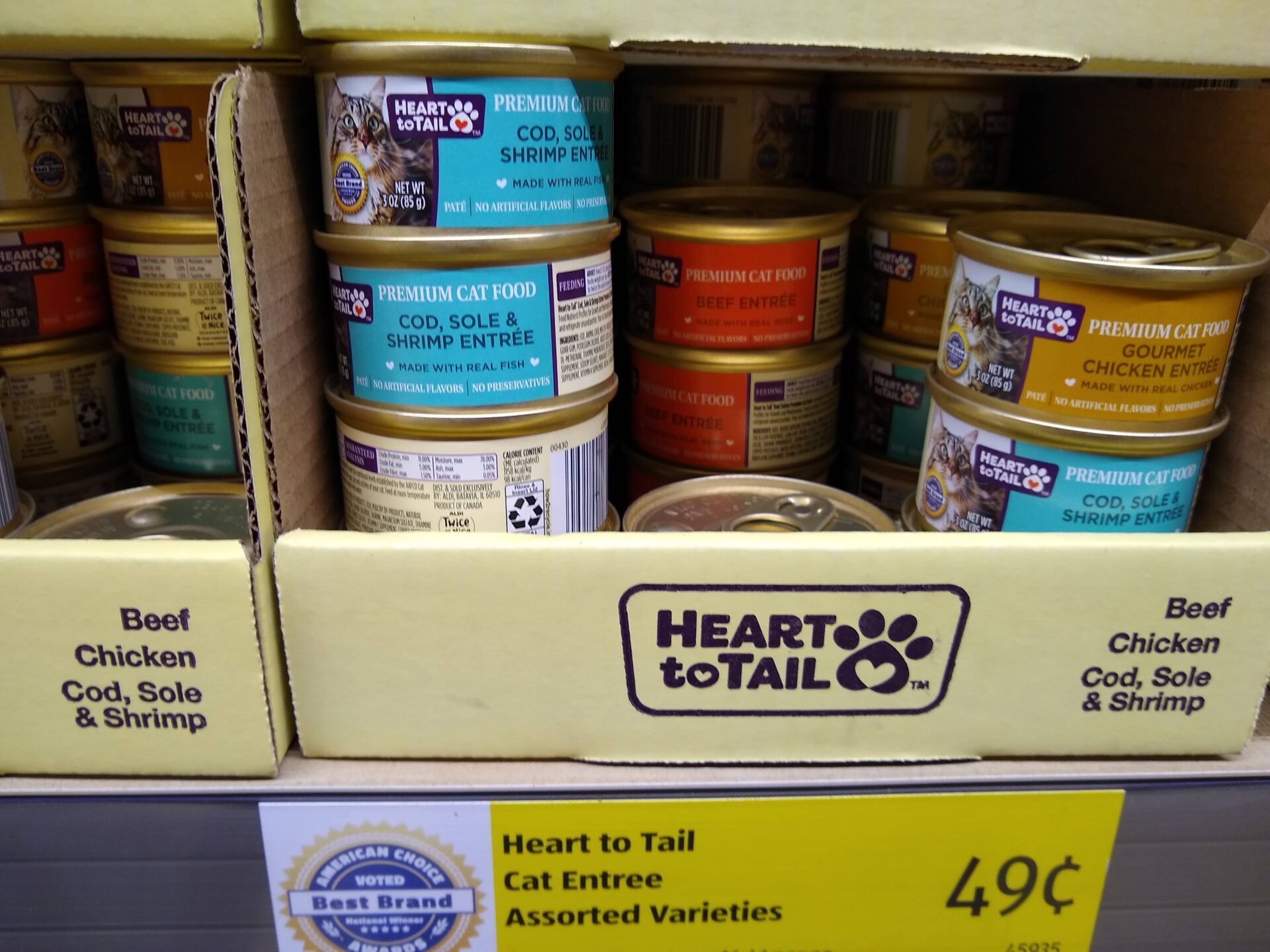
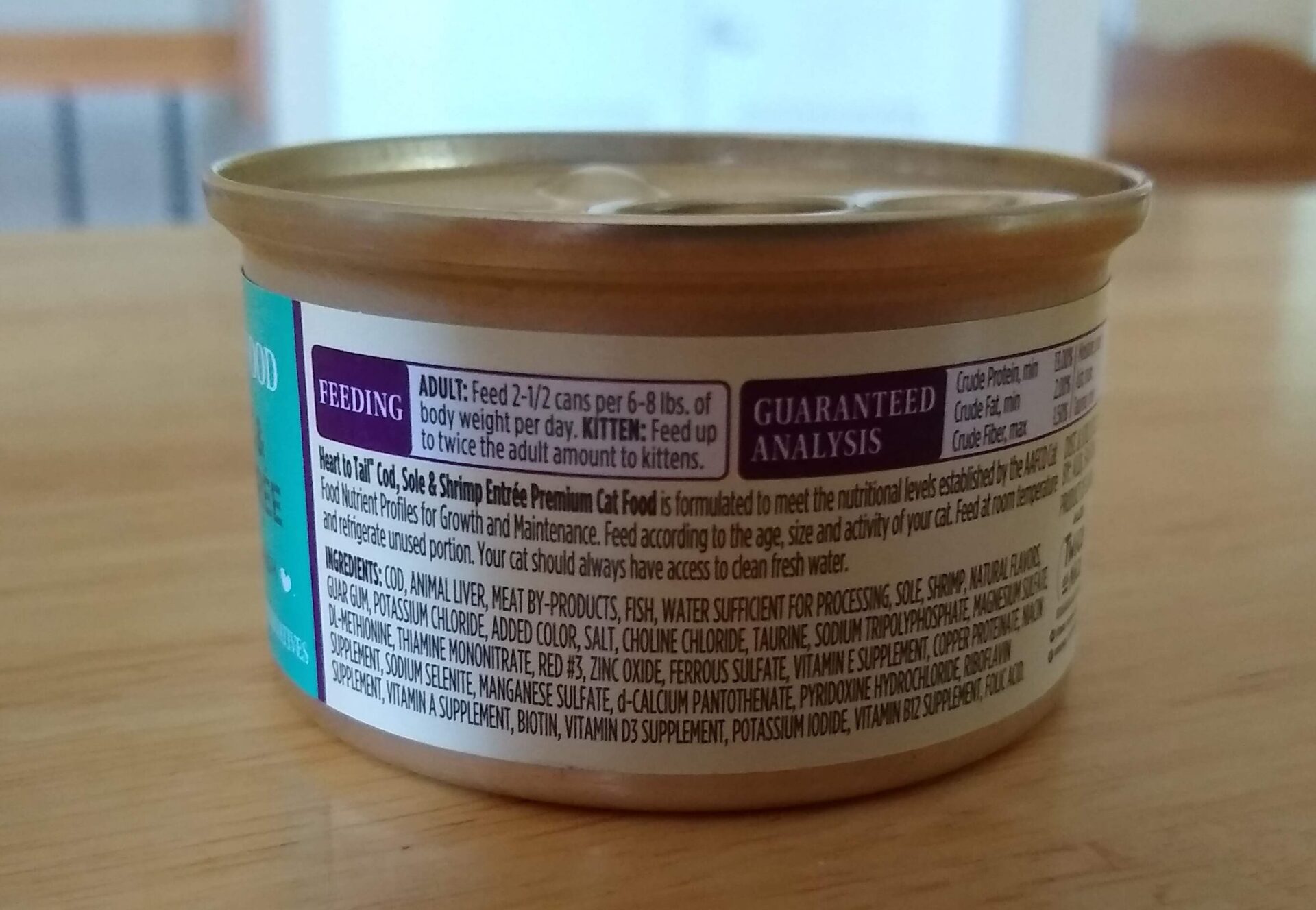
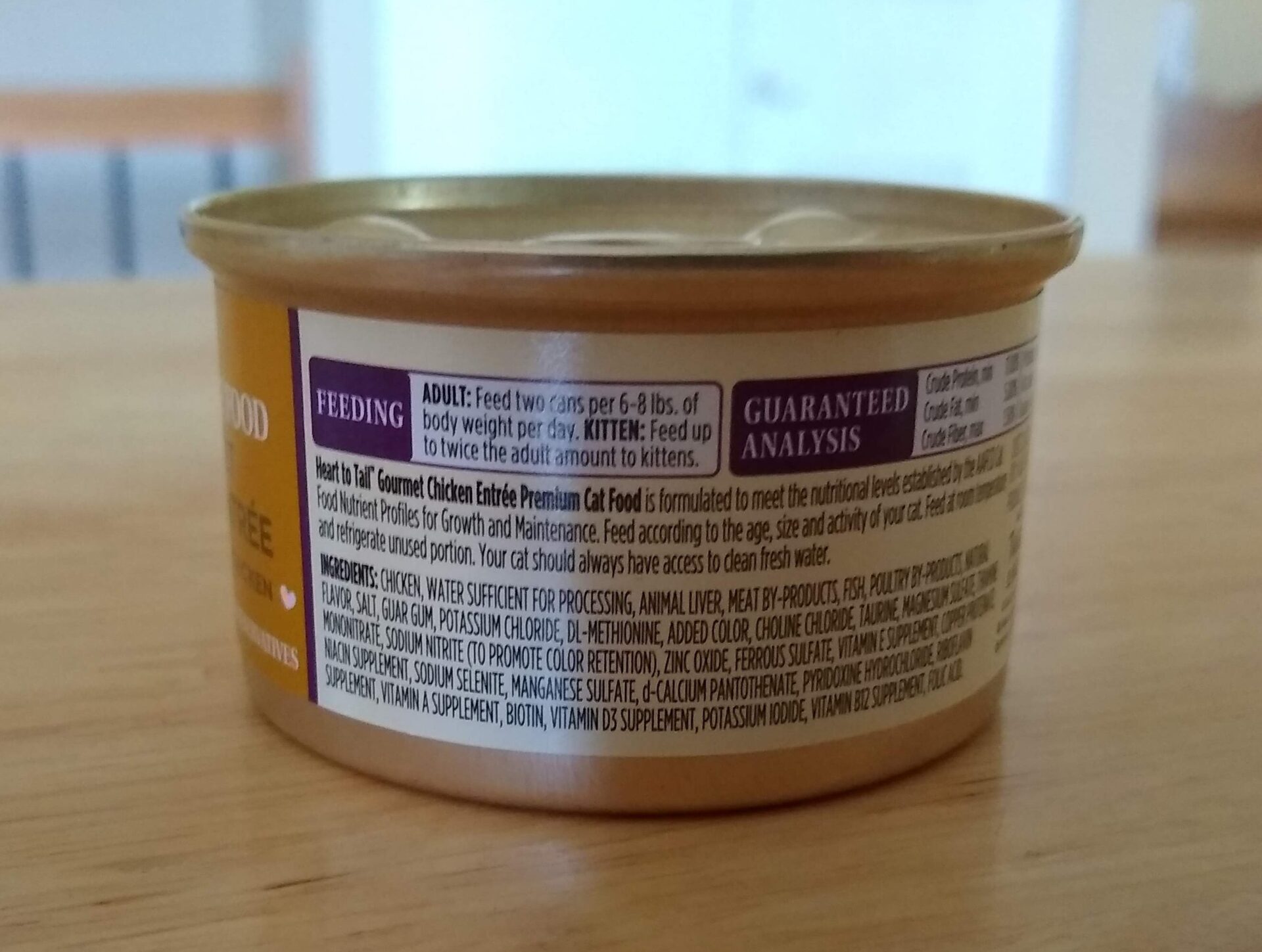
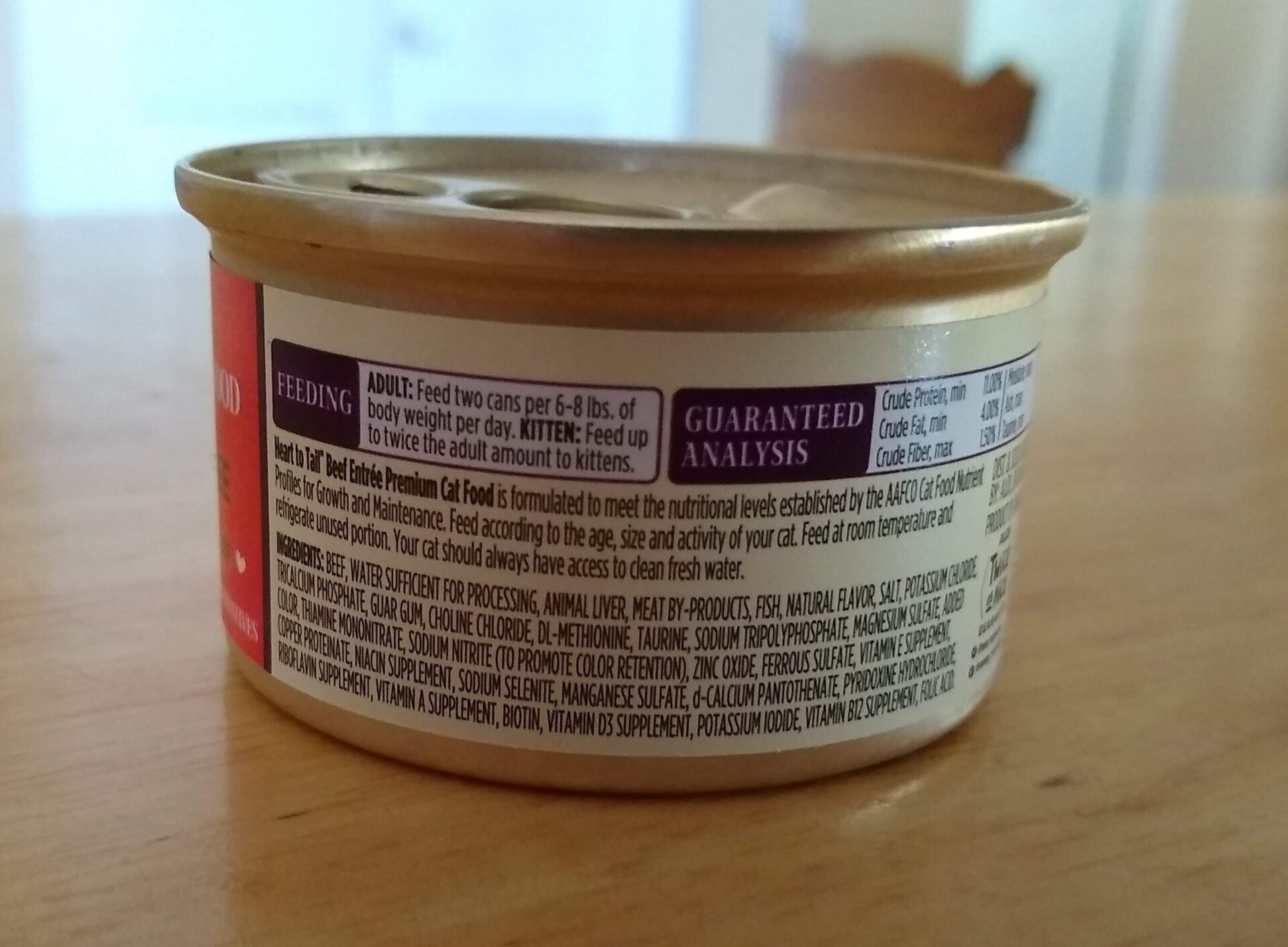
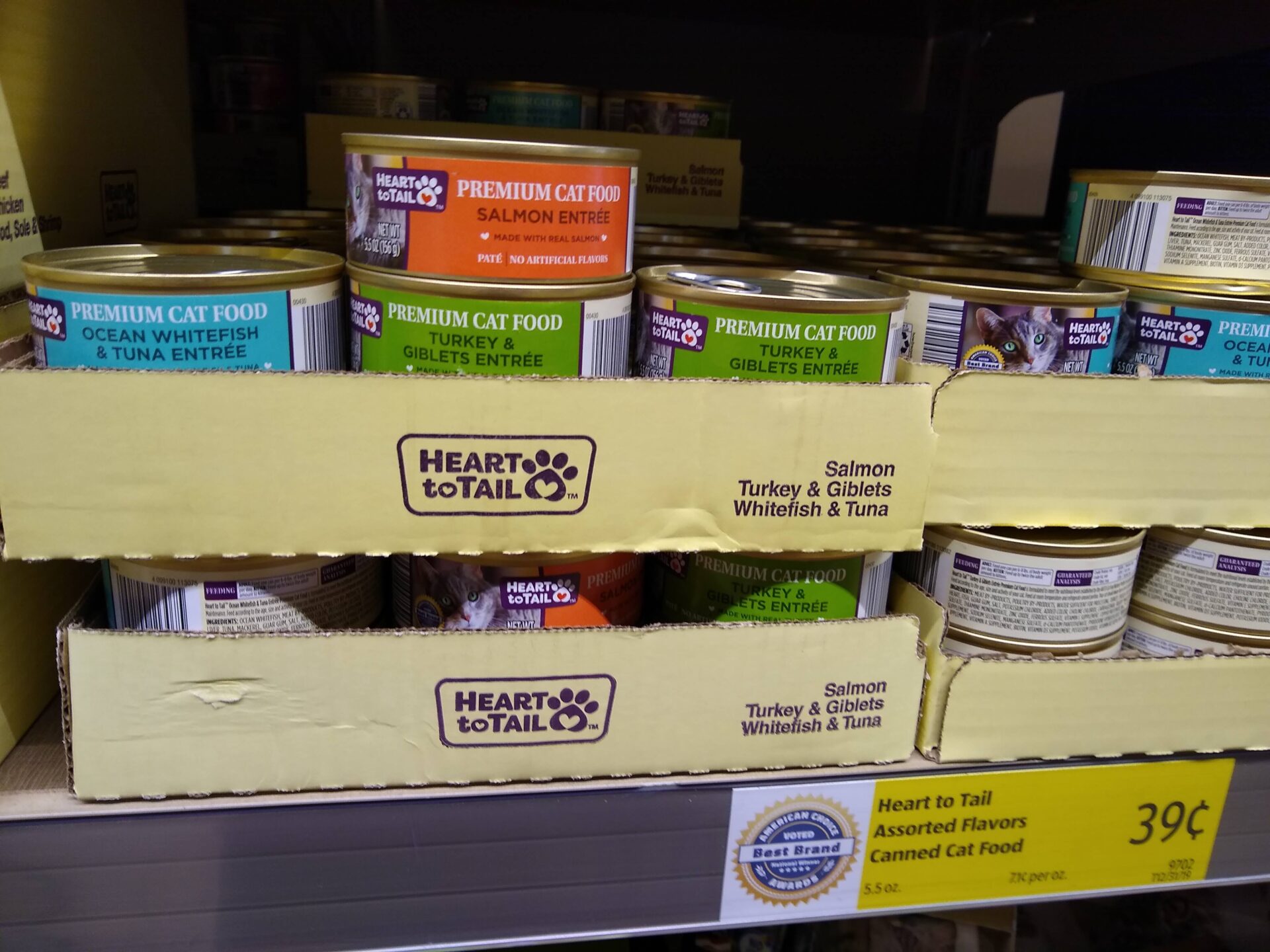
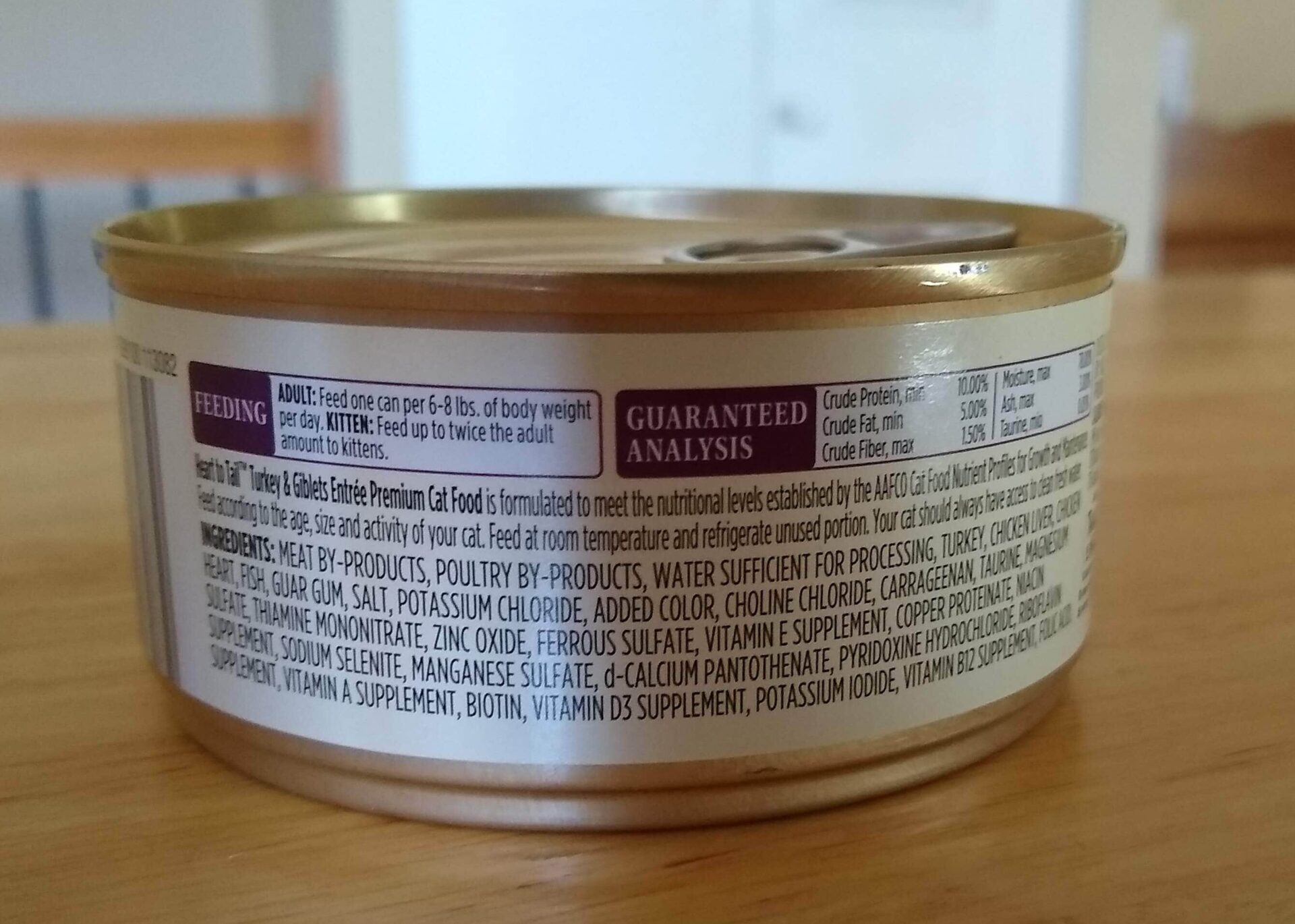
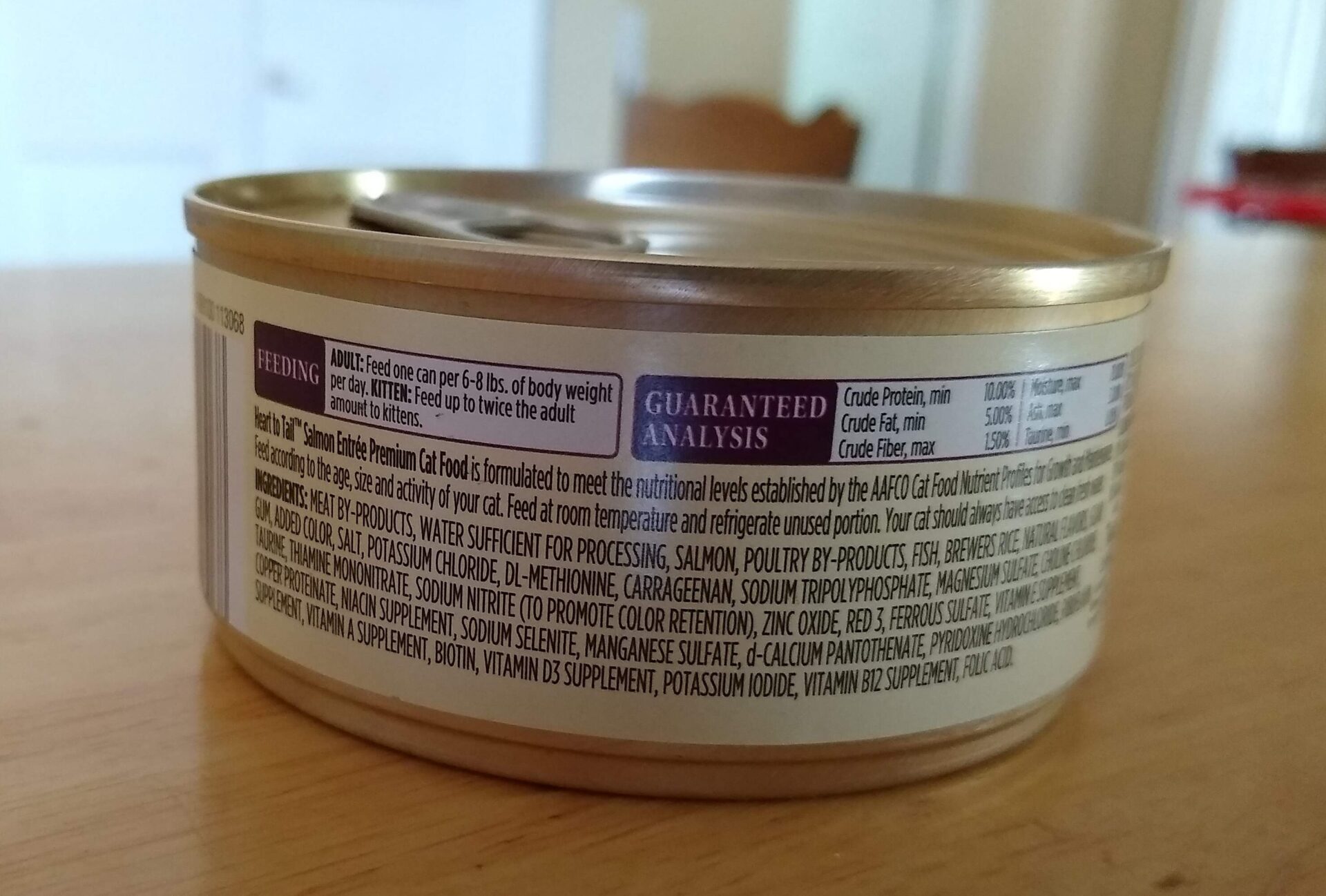
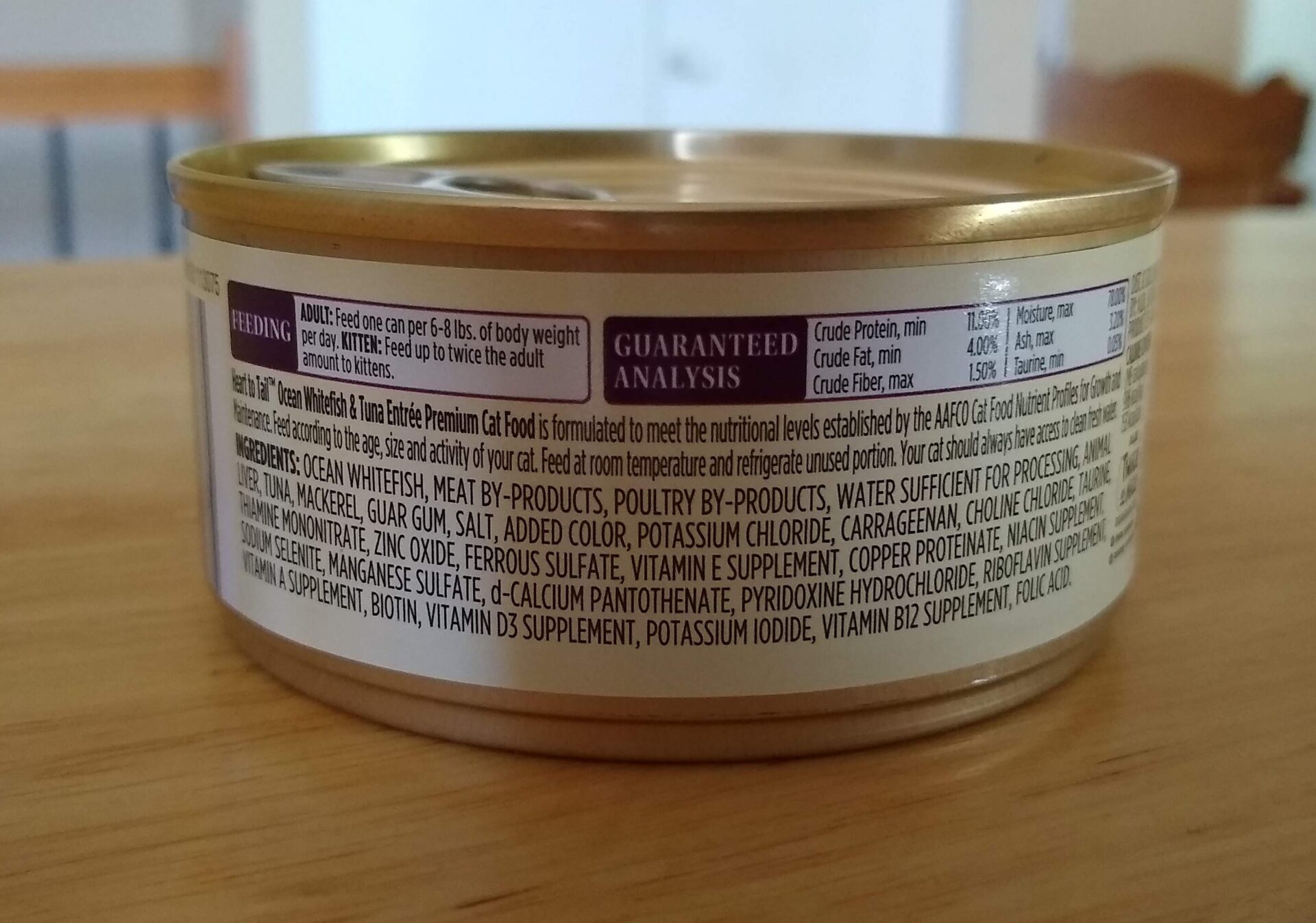
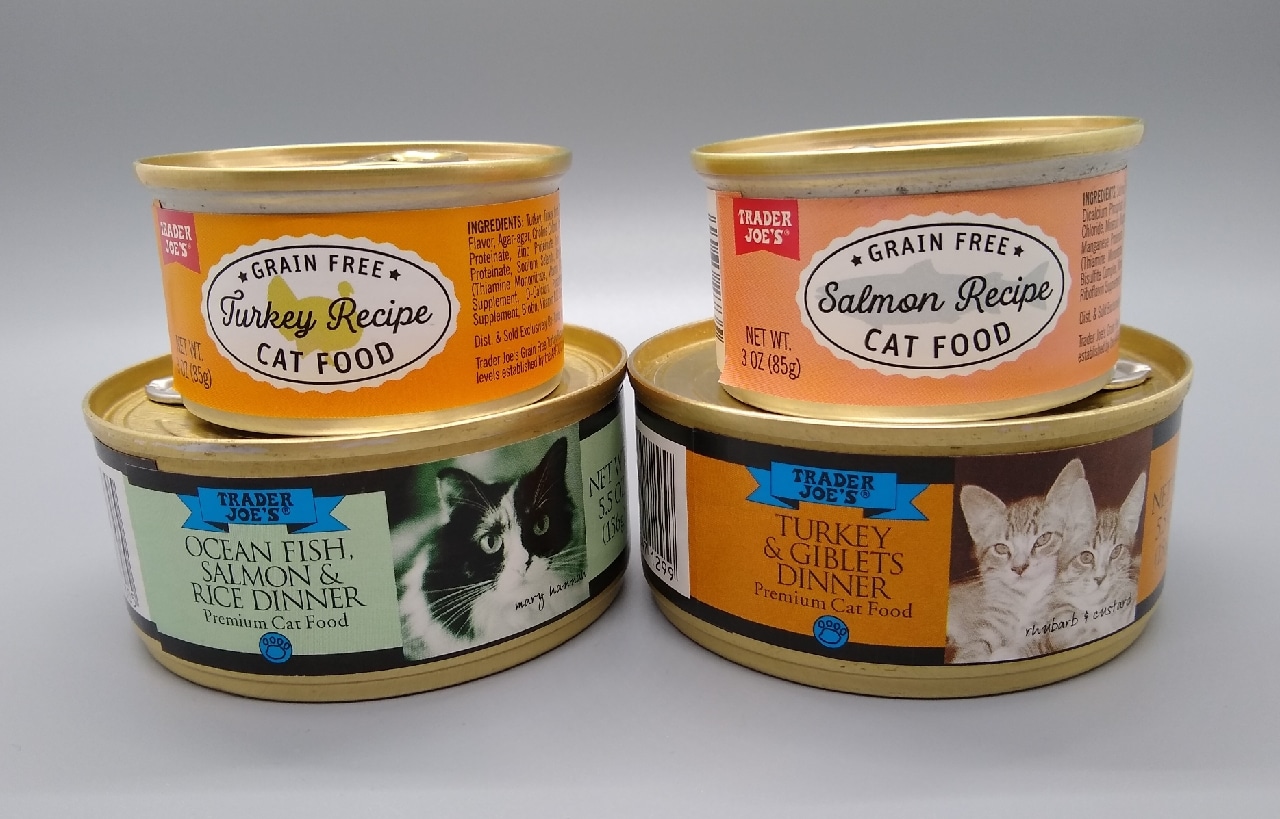
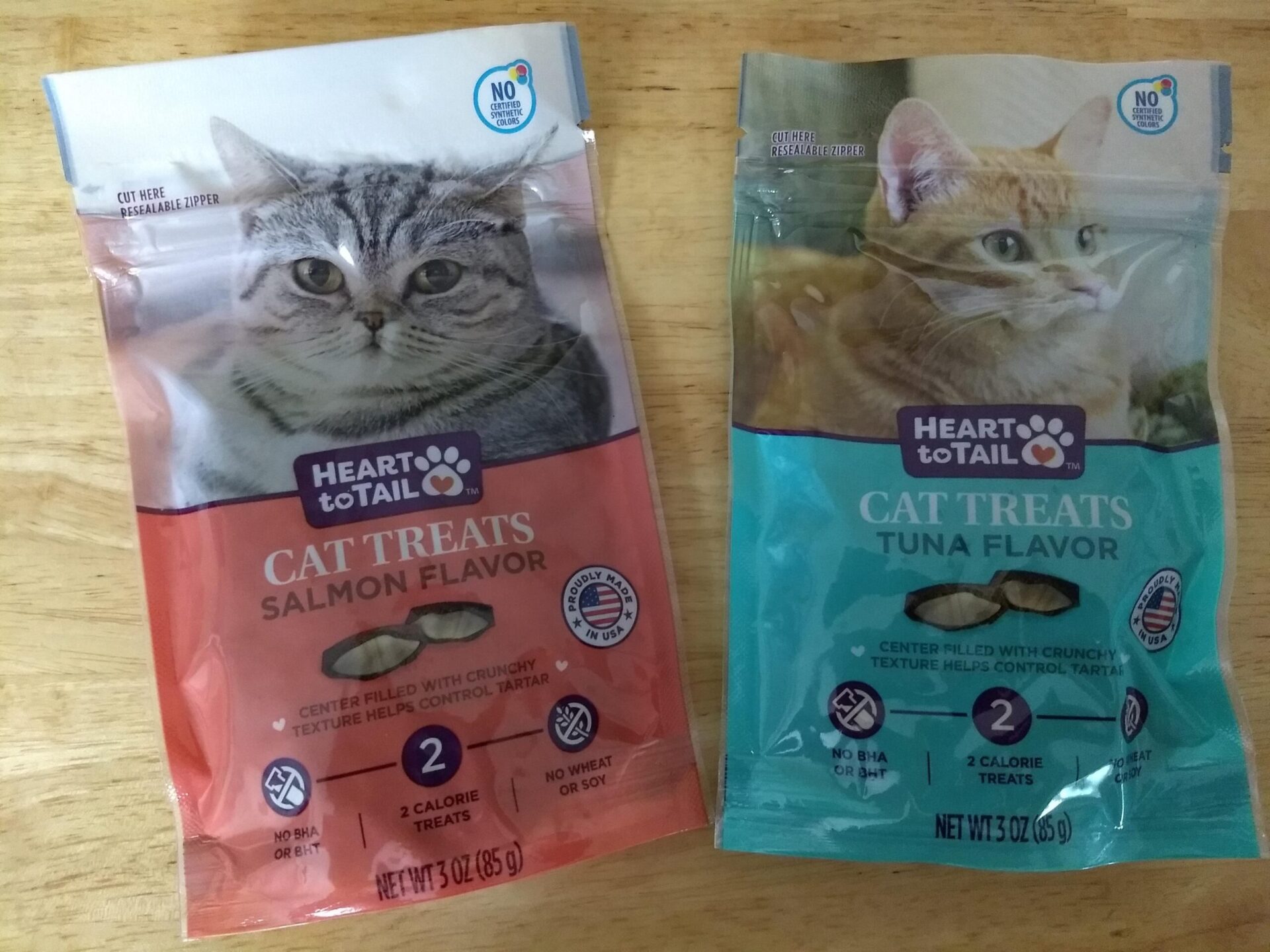

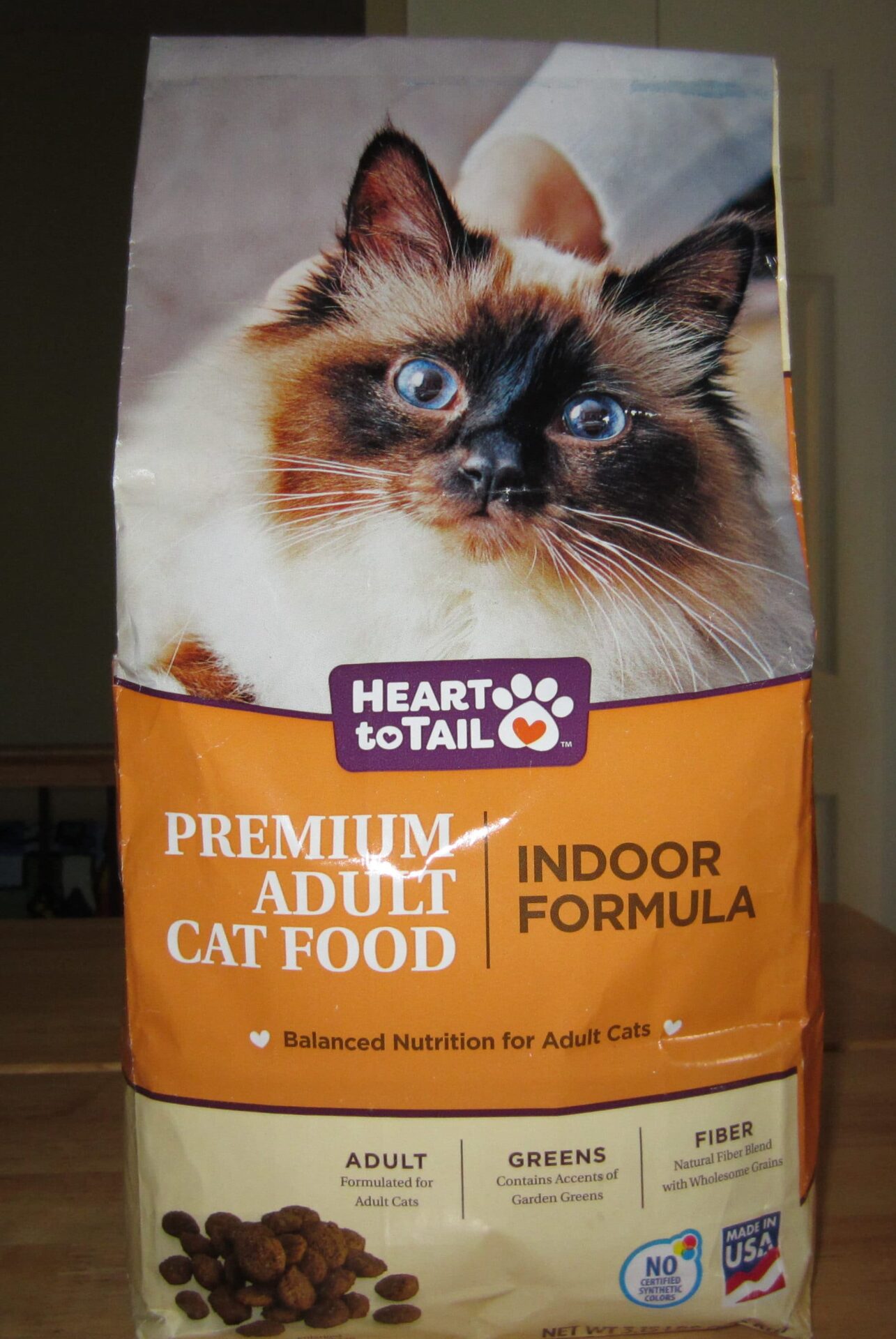
Hi Rachael. This is a great review on what looks like a very good, though small, line of wet cat foods for a super affordable price at uber discounter Aldi! Thank you!
The smaller, Gourmet cans cost more because they are made with superior ingredients. Note that they have more named meats and higher on their ingredients list, while the larger cans have more by-products and less named meats. This is where the economical nature of the product comes in. I personally am am not convinced whether by-products are a problem. Often this includes some very nutritious protein that humans really don’t want to eat, like tripe and lungs, and that are left over from our consumption of steak, bacon, etc. By products are a way to make use of the whole animal rather than wasting it.
Also the Gourmet line does not contain carrageenan, while the standard line does. This ingredient alone is of concern to some cat owners as the research on it suggests it may cause inflammation or even cancer, though the data is not really clear yet. The same potential issue exists for humans and it’s in a lot of our packaged foods as well.
Still as you note, the moisture in the food is a massive benefit and the larger, non-gourmet cans are still rich in species-appropriate animal protein which cats need. I would certainly prefer folks on a budget feed the very reasonably priced 5.5 ounce cans of this food to their cats over any dry food on the market. These are relatively low in fillers, starches, and carbohydrates, palatable to kitties as you mention, and they look like they deserve a gold star for value based on overall quality. Thank you again!.
I agree completely with Ann here with one addition. Cats should consume a low carbohydrate diet, preferably below 10 %. Even the best dry food is 30% carbs and above. Canned food does not list carbohydrates but you can calculate it by adding up the percentage of every other ingredient. The difference of that total and 100 % is the carb content by percentage. For example crude protein, fat , moisture ash and so on adds up to 98, then 2% is carbohydrate.
I am a retired Ph.D biochemist. We have a cat which was recently diagnosed with diabetes, so I have been reading a LOT of cat food labels. I agree with Micheal’s method of calculating carbohydrate content, but I have encountered two problems. First, many labels (or web sites) do not include the ash levels. Apparently it is usually in the range of 2% to 3.5%, but this still results in a relatively large uncertainty in the amount of carbohydrate. The second problem is that you should be able to calculate the total calories in the food from the analysis. If you assume that you have 100 grams of food, the percentages will be the number of grams of that component in the 100 grams of food. The analysis for the Turkey and giblets entree is an example: crude protein min. of 10%, crude fat min. of 5%, crude fiber max. of 1.5%, moisture max. of 78%, ash max. of 3%, and taurine min. of 0.05%. Calorie content is 1130 kcal/kg and 176 kcal/can. The main ingredients add up to 98.05%, so the carbohydrate content must be 1.95%, which I will round off to 2%. The rule of thumb numbers are that a gram of protein yields 4 calories of energy, for fat it is 9 calories per gram, and for carbohydrates, it is again 4 calories per gram. So, in 100 grams of this food, we would have 10 grams of protein, equivalent to 40 calories, 5 grams of fat, equivalent to 45 calories, and 2 grams of carbohydrate, equivalent to 8 calories. This adds up to 83 calories in 100 grams of this food. This is equal to 930 calories in 1000 grams or one kilogram. Now, a point of clarification is required. What we refer to as a calorie, is actually what science refers to as a kilocalorie. So, in scientific terms, my energy calculation yields 930 kilocalories per kilogram, yet the label for this food lists the energy content as 1130 kilocalories per kilogram. I find this inconsistency on the vast najority of labels which I have examined. I have no way of knowing whether it is the analysis or the energy content which is off.
Correction: I just noticed an error, The total energy in 100 grams is 93 calories in 100 grams, not 83 calories.
16 yr old finicky, underweight cat gobbles down this canned food. Tried so many different brands that she picks at and walks away, it’s a relief to find something she likes consistently that doesn’t cost 5x the price.
Here’s a tip from my vet, add some water to canned cat food. It will help them consume more hydration and also make them feel more full. So they won’t be pestering me for more food quite so much ( like every time I walk into the kitchen).
I have 2 cats one is diabetic they like heart to tail cat food, both dry and canned. My diabetic cat needs high protein/ low carbohydrates. I can’t find the carbohydrates listed on the dry or canned 5.5 oz cans. I need to know this information. I am only feeding canned food to the diabetic cat trying to keep him stable.
Why not just feed them both dry and wet? I have two neighbourhood strays that visit everyday, so I buy them both Aldi dry & wet and they seem to love it. They’re happy to get anything, seeing as they were previously eating the peanuts I put out for birds & squirrels!
3 times a day my cat gets wet cat food, once a day dry. I also use the dry as treats in his slow self feeder toy. Seems to work well for him and he’s lost weight. Looks good, feels good.
I just bought canned Aldi cat food. I hope he …he just finished his dish of Aldi’s canned cat food. 🤞🏻
Awww. He’s a lucky cutie!
Are they discontinuing the 3oz small cans of Heart to Tail premium gourmet Chicken entree pate cat food? I’ve been to several Aldi’s and can only find the larger cans which my picky cats won’t eat, but they DO love the Chicken. I hope it not’s being discontinued!!
Thanks
No! My aldi sells the 3 oz chicken gourmet entree pate. Maybe your aldi’s are out of stock of the flavor at the moment?
Not all cans state they are pate. My cat gets the runs, and I’m left cleaning hindquarters, if mine eats anything with gravy in it.
Glad I only feed the stray kitties. Don’t have to clean ’em! The couple of strays I feed, strangely enough, don’t like pate and don’t seem to like seafood of any kind.
bone meal is a very desirable ingredient, very necessary to cat health. It is one reason why a cat wouldn’t be healthy eating human canned tuna exclusively. When cat’s eat mice, chipmunks, etc. they consume the bones.
Don’t they choke?
My cat will only eat the chicken Heart to Tail from Aldi’s and I can’t get it all the time. Any way of buying it in bulk from any where. I’m desperate.
Same thing with my cat and the Heart to Tail Salmon. I finally found that Winn Dixie has the same food, called Heart & Tails, and same price as I paid at Aldi. BUT the store manager let me know that they’ve “had trouble” getting cat food for a few weeks.
Winn Dixie sells a brand called Whiskers & Tails, which is different than the Aldi Heart to Tail food. Heart to Tail is only sold at Aldi.
Maybe so, but the food at W/D smells the same, looks the same – and my cat eats it, and that’s my goal.
If you’re having trouble finding the canned cat food at Aldi, it probably has to do with increased demand (more people got pets during the past year and a half) along with supply chain disruptions that are causing delays with all kinds of products these days. The problem is not limited to Aldi. Here’s more info: https://www.supermarketnews.com/winning-pet-care/rising-demand-supply-issues-impacting-pet-food-category
My Tuxie Queen loved Aldi brand!!!!l it was my first trip there. I will be back!
I tried the chicken Hart to Tail wet cat food today with my cats. One of them really chowed down and the other walked away. She is pretty finicky and will only eat Bl Buff Wilderness Chicken wet food.
Our PeeWee loves the cat treats from Aldi. Are they available in a larger bag.
I think the cat treats are only available in one bag size.
We have been feeding our cat for about 5 years now, the Heart to Tail Salmon Entree and he loves the taste. It seems to be the most beneficial of all canned cat foods that we have tried him on. He is 18 years old and still gets around good.
The only problem that we are having with this cat food is supply. Aldi does not stock enough supply to meet the demand in our area for it. When restocked, it usually runs out within a day or two, then, it takes weeks, if not months, to restock. Accordingly, we have to buy months worth of cat food in order that our cat does not run out or have to eat a less nutritious diet.
This supply problem has been brought to the attention of Aldi several times now, with no detectable response.
Congrats on having an older cat. Ours is 16 and also still fairly active, which we’re grateful for.
On the supply front, I’m sure Aldi would like to stock enough to meet demand, but as is the case with many products at various retailers these days, it’s probably an issue that extends beyond Aldi’s control and involves manufacturers and/or shipping challenges. Pet food is something a lot of retailers — not just Aldi — have struggled to keep fully stocked during the last year or two. https://www.aldireviewer.com/a-look-at-temporary-product-shortages-at-aldi/
October 2022 Update: Still no supply of Heart to Tail 5.5 oz. canned cat food on the shelves anywhere in our area. We are having to feed our geriatric feline a less nutritious diet that we purchased at Walmart.
It’s sad that Aldi cannot stock their shelves with this product in a more timely and consistent manner.
Canned tuna and canned chicken might be better than Walmart brand pet foods.
I, too, have not been able to find Heart to Tail canned food for a couple of weeks or so.
It’s almost the only brand my 17-year old Heloise will eat. I searched for canned food for seniors and the one she’s eating now is for “mature” cats: Wilderness chicken recipe. She eats it almost as eagerly as Heart and Tail. Looking forward to seeing H&T back on the Aldi shelf!